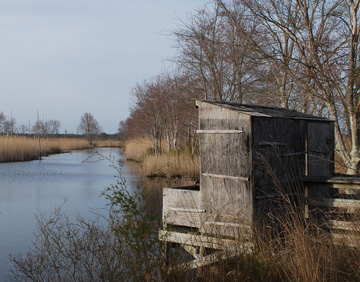Lower Bank Road, Egg Harbor City, NJ
Phone: (908) 234-1225
njconservation.org/bearcreekpreserve.htm
New Jersey Conservation Foundation
Exit Port Republic WMA and turn Left onto Sooys Landing Road, then Right onto CR 624/Clark’s Landing Road. After 6.5 miles, turn Right onto Route 563, then keep Right to merge onto Lower Bank Road/CR 652. After 1.5 miles, park along the side of the road near the gated access road on the Left. DIRECTIONS FROM NEAREST HIGHWAY: From the intersection of Route 50 and Route 30 in Egg Harbor City, continue North on Route 50/Philadelphia Avenue. After 1.5 miles, Philadephia Avenue becomes Green Bank-Egg Harbor Road/Route 563. After another 3.2 miles, bear Right at the fork onto Lower Bank Road/CR 652. After 1.5 miles, park along the side of the road near the gated access road on the Left. Map
A single dirt road winds its way from the entrance gate through the various habitats described, goes by freshwater impoundments specifically provided for breeding waterfowl, and leads to two small bird blinds, one facing the impoundments, one facing the Mullica River.
 |
| Bird Blind at Bear Creek Preserve | Tony Geiger |
| |
| | Bear Creek preserve provides a unique view of the small inland waterways that course through coastal southern New Jersey. This preserve occupies the southern bank of the Mullica River just upriver from the small village of Lower Bank in Burlington County. Small boat manufacture in Lower Bank pre-dates the American Revolution. A sand road travels over a mile and a half through Atlantic white cedar swamp, pine-oak upland and fresh and brackish impoundments, making for excellent wildlife viewing any time of year.
An active breeding pair of Bald Eagles is in the vicinity of Bear Creek, often seen perched in the treeline or in the standing dead cedars on the opposite or northern shoreline of the Mullica River during winter and spring. The Mullica River and its basin provide the ideal mixture of habitats for nesting eagles.
Waterfowl include Bufflehead, Double-crested Cormorant, Common and Hooded Merganser and Pied-billed Grebe. Belted Kingfisher and Great Blue Heron overwinter as well. Scan the treeline for Bald Eagle and Red-Shouldered Hawk. White-tailed deer, raccoon, opossum, and red fox are more visible.
Migrant songbirds include Blue-winged, Black-throated Green, Northern Parula and Magnolia Warblers and Yellow-billed Cuckoo. River Otter and Muskrat are active. Osprey return to nesting platforms. Black Ducks and Mallards begin nesting. Least Bittern, King Rail and Sora call at dusk among the spring peepers, chorus frogs, gray treefrogs, wood frogs and pine barrens treefrogs. Wood Ducks nest in provided boxes.
Mountain laurel, sheep laurel, and highbush blueberry bloom in the understory. Look for the tiny yellow blooms of Pine Barrens heather in bare, sandy areas along the trail. Snapping turtles, diamondback terrapins, and painted turtles nest along the dike. Keep an eye out for pine snake, milk snake, Northern water snake and the elusive rough green snake in trees. Egrets and Herons spear minnows in the shallows. Tree, barn, bank and rough-winged swallow can be seen by day. Bats take their place catching insects at night.
Red maples, sweet gums and river birches turn beautiful colors among the laurel and white cedar. Green-winged and Blue-winged teal, Ruddy Duck, Canvasback, Gadwall, Scaup, Wigeon and Pintail are among waterfowl that utilize the impoundments. Bald Eagles, Osprey, Red-tailed Hawk, Peregrine Falcon, Merlin and Sharp-shinned Hawk are among raptors utilizing the river as a migration corridor.
|